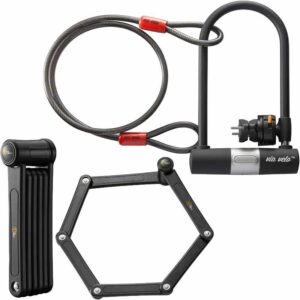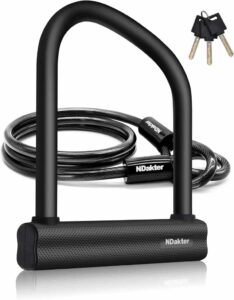Can I Charge My Electric Bike From My Car?
Charging an e-bike from a car is a fascinating concept that intrigues many bike enthusiasts. The process involves using your car’s battery to power up your electric bike, typically through an inverter and a car adapter. This can be particularly useful on long trips where charging stations might be scarce.
In this post, we’ll explore whether it’s feasible and practical to charge an e-bike battery using a car. We’ll cover the necessary equipment, such as a car charger converter and dual USB ports, and discuss the importance of charging your battery safely. Additionally, we’ll compare charging from a car battery to using an electric car charging station, ensuring you’re well-informed.
Key Takeaways
- Charging an e-bike from a car requires an inverter and a car charger converter to match power outputs.
- A standard car battery can power an e-bike battery, but monitoring is crucial to avoid overcharging.
- Safety measures, such as proper disconnection and avoiding overcharging, are essential.
- Electric car charging stations provide a more robust and controlled alternative for charging e-bikes.
- Dual USB ports and car charging stations add flexibility for long trips with limited charging options.
Understanding the Basics of E-bike Batteries
Understanding e-bike batteries involves knowing their power needs and efficient charging methods. When charging an e-bike from a car, using an inverter to synchronize the power output is vital. While a car battery can recharge an e-bike battery, careful monitoring is required to prevent overcharging.
Portable car charging stations with dual USB ports offer versatile options, particularly for extended trips. Alternatively, electric car charging stations provide controlled environments for battery charging.
Incorporating these tools can make the difference between a smooth ride and unexpected stops, especially when relying on car charging systems.
How E-bike Batteries Work
Understanding electric bike batteries involves looking at their charging cycles and components. E-bike batteries consist of cells that store energy, managed by a Battery Management System (BMS). When charging an e-bike from a car, an inverter efficiently converts the car battery’s power to the correct voltage for the e-bike.
Car charging stations are useful, but a car charger converter or car adapter may offer a more portable solution. Ensuring the connections between the e-bike battery and the charging source are secure is crucial for efficient charging. Always turn off the vehicle to avoid draining the car battery.
If issues arise during the process, seeking advice from specialized forums or contacting support can be beneficial. Using the right equipment and understanding each component ensures a safe and efficient charging experience.
Types of E-bike Batteries
Different e-bike battery types cater to varying needs and preferences. Lithium-ion batteries dominate the market due to their balance of weight, capacity, and longevity. They are ideal for charging an e-bike from a car setup, especially with an inverter. Nickel-metal hydride (NiMH) batteries, known for higher energy density compared to older technologies, are less common today. Lead-acid batteries, though heavier and less efficient, offer affordability and robustness, making them suitable for budget-conscious riders.
dominate the market due to their balance of weight, capacity, and longevity. They are ideal for charging an e-bike from a car setup, especially with an inverter. Nickel-metal hydride (NiMH) batteries, known for higher energy density compared to older technologies, are less common today. Lead-acid batteries, though heavier and less efficient, offer affordability and robustness, making them suitable for budget-conscious riders.
Car adapter solutions can be handy for convenient on-the-go charging. Experienced riders emphasize the importance of secure connections and proper voltage settings to prevent damage. Engaging with specialized forums can provide valuable insights into optimizing your e-bike’s performance.
The Role of a Car Battery in Charging an E-bike
A vehicle’s battery plays a crucial role in charging electric bikes, offering an efficient way to recharge on the go. Using an inverter to convert DC to AC ensures compatibility with e-bike chargers. Ensure the inverter’s output matches the bike’s charging requirements to prevent damage. Charging stations at rest stops can serve as a backup plan. Always monitor the vehicle’s battery level to avoid depleting it entirely.
Integrating these methods requires proper equipment and an understanding of the vehicle’s capabilities. Online forums can provide useful tips and feedback. For long trips, a reliable car charging station offers convenience and peace of mind. Balancing the demands of both the e-bike and the vehicle ensures a smooth journey.
The Power Output of a Standard Car Battery
A standard vehicle battery typically outputs around 12 volts, with a capacity of 40-70 Ah. This is sufficient for charging e-bikes, but be cautious of the inverter’s capacity.
Using an inverter, DC is converted to AC, which your e-bike requires. Ensure the inverter’s output aligns with your bike’s needs to avoid damage. Monitor the vehicle’s battery level to prevent it from running low.
Car charging stations at rest stops are great alternatives for longer trips. Feedback from online threads suggests that experienced riders favor using inverters for convenience. For optimal performance, always monitor both the vehicle and e-bike’s power levels.
Charging an e-bike from a car might seem straightforward, but proper equipment and understanding are key to a smooth experience.
The Connection Between Car Battery and E-bike Battery
The connection between a vehicle’s battery and an e-bike’s battery is significant when considering charging an e-bike from a car. Utilizing an inverter, you can convert DC to AC to charge your bike. Ensure the inverter’s capacity matches the bike’s requirements to avoid damage.
Charging stations at rest stops offer an alternative for longer trips. Feedback from various online threads indicates that experienced riders prefer inverters for convenience.
alternative for longer trips. Feedback from various online threads indicates that experienced riders prefer inverters for convenience.
Always monitor both vehicle and e-bike power levels to prevent issues. Using car charging stations can also be viable, but proper equipment and understanding are crucial for a smooth experience. This method ensures that your e-bike remains powered up, making your journey hassle-free and enjoyable.
Remember to safeguard your vehicle’s battery from draining completely.
Tools Required for Charging an E-bike from a Car
Charging an e-bike from a vehicle requires specific tools. An inverter is essential to convert the vehicle’s DC power to AC, which is suitable for the bike’s charger. Ensure the inverter’s wattage matches the e-bike’s charging requirements. A quality inverter can ensure efficient power conversion.
Additionally, a reliable connection via alligator clips or a cigarette lighter plug is necessary for secure power transfer. Always use a cable with an appropriate gauge to handle the current without overheating.
For safety, regularly check the vehicle’s battery level to avoid depletion. This setup allows seamless integration, turning your vehicle into a mobile charging station for extended e-bike journeys.
The Importance of a Car Charger Converter
A car battery inverter is essential for charging e-bikes from cars. Paired with a converter, it transforms the vehicle’s DC power to AC, compatible with

the bike’s charger.
Choosing the right converter ensures seamless charging, especially during long rides away from traditional charging stations. It provides the convenience of turning your vehicle into a mobile charging station, extending your e-bike’s range effortlessly.
Don’t forget to use proper cables and connections to match your bike’s power requirements. This setup safeguards both your vehicle’s battery and the e-bike’s charging needs.
For those embarking on extended e-bike adventures, equipping your vehicle with a reliable charger converter is a game-changer, offering the freedom to explore without range anxiety.
How to Use Dual USB Ports for Charging
Charging an e-bike from a car’s USB ports is technically possible but not the most efficient method due to several limitations. USB ports typically deliver lower voltage and amperage compared to what e-bike batteries require, resulting in significantly longer charging times and potential damage to the battery over repeated use.
For effective charging, an inverter is recommended. An inverter converts the car’s 12V DC power to the AC power needed by most e-bike chargers. This method ensures the charger receives the correct voltage and amperage, facilitating a safer and more efficient charging process. Sources like MudBike and Reddit highlight that while using USB ports can be convenient in emergencies, it’s not ideal for regular use
If you’re looking to charge your e-bike while on the go, consider using a power inverter that matches your e-bike’s charging requirements or exploring specialized adapters designed for this purpose. This setup ensures that you can keep your e-bike charged efficiently without compromising battery health or experiencing excessively long charging times.
Step-by-Step Guide to Charge Your E-bike from a Car
PLEASE NOTE: Before charging your electric bike from a car, it’s crucial to thoroughly review any documentation that comes with the tools you are using, as well as your vehicle’s manual. This ensures you understand the specifications, compatibility, and safety precautions necessary to avoid damage to either the vehicle or the e-bike. Proper adherence to the guidelines provided by manufacturers will help prevent potential issues and ensure a smooth, safe charging process.
Prepare the Inverter: Connect an inverter to the car’s 12V socket. This inverter will transform the car’s DC power to AC, making it suitable for your bike’s charger.
Connect the Charger: Plug the e-bike’s charger into the inverter. Ensure the car is running to prevent excessive drain on its battery.
Monitor the Charging Process: Periodically check the charging process to avoid overheating or overloading the system. Ensure all connections are secure to prevent accidental disconnections.
Use Car Charging Stations: For long trips, consider using car charging stations, which offer dedicated power solutions for electric vehicles.

AEZ-2024-Upgraded-Charger-Level Specialized Adapters: Explore specialized adapters like the AEZ-2024-upgraded-charger for electric bikes, which can streamline the charging process and enhance compatibility.
Community Insights: Engage with online communities by leaving comments or sharing your experiences for additional tips and insights.
Connecting the E-bike Battery to the Car Battery
Ensure Compatibility: Before connecting, make sure the car battery and e-bike battery are compatible.
Use a Power Inverter: Connect the inverter to the car’s 12V socket to convert DC power to AC, which your e-bike charger can use.
Connect the Charger: Plug the bike’s charger into the inverter and ensure the car is running to prevent battery drain.
Secure Placement: Place the bike in a safe spot during charging to avoid accidental disconnections.
Public Charging Stations: For longer trips, locate public car charging stations that offer reliable power for your e-bike.
Balance Power Needs: Monitor and balance the power needs of both the car and the e-bike to ensure optimal charging efficiency.
Monitoring the Charging Process
Monitor Voltage Levels: Keep an eye on the voltage levels to ensure the battery doesn’t overheat.
Track Charge Duration: Regularly check the charge duration to prevent overcharging, which could damage the battery.
Secure Connections: Ensure all connections are secure to avoid inconsistent charging.
Community Feedback: Utilize feedback from forums and online communities for tips on optimizing your setup.
Dependable Charging Stations: During longer trips, use dependable car charging stations designed for electric cars that can also power your e-bike.
Energy Balance: Balance the energy needs of both the car and the e-bike to prevent unexpected battery depletion and ensure optimal performance.
Safety Measures to Consider While Charging an E-bike from a Car

When charging electric bikes using your car, ensure the power inverter is compatible with your bike’s charging requirements. Secure all connections to avoid loose wires, which can cause sparks or fires and serious damage. Be mindful of the car’s battery capacity to prevent excessive drain, which could leave you stranded.
Park in a well-ventilated area to prevent overheating. Regularly inspect the cables for wear and tear, replacing them if needed. Consider using reliable adapters like the J1772 EV Adapter. Balance the energy needs of both your bike and your car, especially during long trips. User comments from forums can provide valuable insights. Charging stations designed for electric cars can also be useful for your bike, ensuring a seamless charging experience.
Overcharging Risks and How to Avoid Them
Avoiding overcharging is crucial when charging your bike from a car. Overcharging can damage both the bike’s battery and the car’s electrical system. To mitigate these risks, always monitor the charging process.
Using a car charging station specifically designed for electric cars can offer a safer, more controlled environment. Avoid leaving the bike connected for prolonged periods, especially overnight, to prevent potential overheating and battery degradation. User comments often suggest setting reminders to check the charging status periodically.
 Ensure your bike’s charging setup includes appropriate voltage regulation to balance energy flow and prevent surges that might lead to overcharging. Following these safeguards will ensure your bike’s longevity and reliability, making your rides enjoyable and stress-free. Always refer to the manufacturer’s guidelines for optimal charging practices.
Ensure your bike’s charging setup includes appropriate voltage regulation to balance energy flow and prevent surges that might lead to overcharging. Following these safeguards will ensure your bike’s longevity and reliability, making your rides enjoyable and stress-free. Always refer to the manufacturer’s guidelines for optimal charging practices.
Safe Disconnection of the E-bike Battery
Carefully disconnecting the power source from your bike is crucial. Before you proceed, always switch off the bike to avoid electric shock. Locate the disconnection latch or release mechanism and gently disengage the connectors without pulling on the wires directly to prevent accidental damage to the components.
After disconnection, store the power source in a cool, dry place to maintain its longevity. When charging from a car, use stations specifically designed for such purposes, as they regulate voltage to ensure a safe and steady charge.
User comments highlight the importance of regular maintenance checks to keep your bike in optimal condition. Always follow the manufacturer’s guidelines for disconnection and charging methods to prevent any mishaps. Properly handling your bike’s power source guarantees a seamless riding experience.
Exploring Other Charging Options: Electric Car Charging Stations
When exploring other charging options, consider the vast network of electric car charging stations available. These hubs aren’t just for cars; they often provide solutions for other electric vehicles as well. Charging your electric bikes using an adapter at these stations can be a game-changer, allowing you to draw power directly and ensuring that you’re always ready to ride.
Using a single-function adapter can convert your car’s output to suit various devices. It’s crucial to ensure the adapter matches your bike’s specifications to prevent any issues. Engaging with user comments can provide valuable insights into the effectiveness and reliability of different adapters.
By exploring these avenues, you diversify your charging options, making your bike journeys smoother and more flexible.
Understanding Electric Car Charging Stations
Understanding the nuances of electric car charging stations reveals flexible power options for your electric journey. When charging an e-bike from a car, an adapter plays a crucial role, allowing you to tap into the car’s power and ensuring your bike is always ready for action.
Reviewing user comments helps gauge the reliability of different adapters. The J1772 EV adapter, for example, offers a streamlined solution, converting power efficiently for your needs.
Each station’s purpose is to provide seamless energy transfer, catering to various electric vehicles. This flexibility makes your travels smoother, eliminating the need for multiple stops.
makes your travels smoother, eliminating the need for multiple stops.
With these insights, your electric ride remains uninterrupted, benefiting from diverse power sources at charging stations and adapting effortlessly to your route’s demands.
The Feasibility of Charging an E-bike at Electric Car Charging Stations
The feasibility of powering your e-bike from car charging stations depends on several factors. These stations, designed primarily for vehicles, often provide higher voltage levels that may not suit all e-bikes. However, many modern stations include multiple connection options that can potentially accommodate e-bikes.
A key consideration is the adapter. Ensure it matches the station’s output and your bike’s requirements. Some stations might not directly support e-bike charging, necessitating additional accessories.
User reviews and forums offer insights into the practicality of specific adapters and station compatibility. Balancing the charge between different devices at these stations can be tricky but manageable with the right equipment.
By exploring station capabilities, reviewing user feedback, and understanding the technical specifications of your bike, you can make an informed decision. Charging an e-bike at car charging stations is feasible but requires careful planning and appropriate tools.
Here’s how it works:
Adapter Connection: The J1772 to NEMA 5-15/5-20 adapter converts the J1772 plug to a standard electrical outlet format (NEMA 5-15 or 5-20). This lets you plug in your e-bike charger as if you were connecting it to a regular household outlet.
Power Compatibility: Many e-bike chargers are designed to handle a range of input voltages, often including the 220-240V output typical of EV charging stations. Ensure your e-bike charger can accept this voltage to avoid damage.
Charging Process: Once connected, the charging station will provide power to your e-bike charger through the adapter. This method can be particularly useful for quick top-ups when you’re out and about and have access to public EV charging stations.
Q&As
Q: Is it possible to charge an electric bike from a car battery?
A: Yes, it is possible to charge an electric bike from a car battery. However, it’s not as straightforward as plugging it directly in. You will need specific tools, such as an inverter to convert DC to AC power, and a car charger converter to ensure the process is safe and efficient.
Q: What tools are necessary for charging an e-bike from a car?
A: You’ll need a power inverter to convert the car’s DC power to AC, matching the voltage and current requirements of your e-bike battery. Dual USB ports can be handy if your e-bike charger is compatible with USB charging. Additionally, having proper cables and connectors is crucial to ensure a secure connection between the car battery and the e-bike battery.
Q: How long will it take to charge my e-bike using a car battery?
A: The charging time depends on the capacity of your e-bike battery and the power output of your car’s battery. Typically, car batteries have a lower power output compared to standard e-bike chargers, so it might take longer to charge. Always monitor the charging process to avoid overcharging and ensure safety.
Q: Are there any safety concerns when charging an e-bike from a car?
A: Yes, safety is a significant concern. Ensure you use a proper power inverter and car charger converter to avoid damaging your e-bike battery. Overcharging is a risk, so monitor the charging process closely. Make sure all connections are secure and avoid charging in extreme weather conditions to prevent accidents.
Q: Can I use an electric car charging station to charge my e-bike?
A: Yes, using an electric car charging station is feasible for charging an e-bike. These stations often provide a more stable and higher power output compared to a regular car battery. Before using one, ensure that your e-bike charger is compatible with the station’s output to avoid any damage.
Q: What are the benefits of using a car charging station over a regular car battery?
A: Car charging stations typically offer higher and more stable power output, which can reduce charging time and provide a safer, more efficient charging process. They are designed to handle the demands of electric vehicles, making them a reliable option for charging your e-bike during long trips.
Q: What should I do if my e-bike battery or car battery overheats during charging?
A: If either the e-bike battery or the car battery overheats during charging, immediately disconnect the power source to prevent damage or potential hazards. Allow both batteries to cool down in a well-ventilated area before attempting to charge again. If overheating persists, consult a professional for further assistance.
Q: Can I charge other devices from my car while charging my e-bike?
A: Yes, you can charge other devices from your car while charging your e-bike, but be aware that this may reduce the charging speed for all connected devices. Ensure that your car battery has enough capacity to handle multiple devices simultaneously without draining too quickly.
Q: Is there a risk of draining my car battery completely when charging my e-bike?
A: Yes, there is a risk of draining your car battery completely if you are not careful. To avoid this, keep the car engine running during the charging process, or monitor the car battery’s charge level closely. Investing in a high-quality power inverter with battery protection features can also help mitigate this risk.
Q: Are there specific brands or models of inverters and converters recommended for this process?
A: Some well-regarded brands for power inverters and car charger converters include Bestek, AIMS Power, and Samlex America. When selecting an inverter or converter, ensure it matches your e-bike’s charging specifications and has good user reviews for reliability and safety.
Ensuring Your Electric bike is Always Ready to Roll
Charging an electric bike from a car is indeed feasible, provided you have the right tools and understand the process. It’s essential to use a power inverter and car charger converter, and to monitor the charging process to ensure safety and efficiency. This method can be particularly useful in emergencies or when you’re on the road without access to traditional charging stations.
While charging your e-bike from an electric car charging station offers another option, it’s crucial to understand the compatibility and power requirements. Exploring these alternatives can provide flexibility and peace of mind, ensuring your e-bike remains charged and ready for your next adventure.
In summary, being prepared with the necessary tools, understanding the charging process, and considering various charging options will help you maintain your e-bike’s battery health and ensure a smooth ride. Whether you’re on a long trip or just need a quick top-up, these methods offer practical solutions to keep your electric bikes powered up and ready to go.







